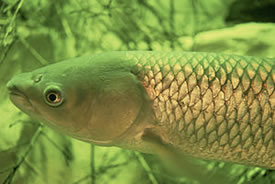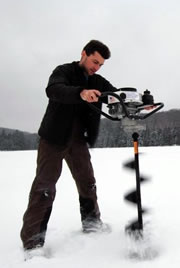Grass carp: The new aquatic invader

Grass carp (Photo by Eric Engbretson, USFWS)
There has been a great deal of attention paid to the Asian carp invasion in recent years, and recently some devastating news was released: grass carp (Ctenopharyngodon idella) are probably already spawning in the Great Lakes basin(1). This represents a benchmark in the invasion process — individuals are often introduced, but until they survive and start to breed, the species is not considered established. Once a species does establish though, there is usually little that can be done to get rid of it.
Grass carp are just one of many species of Asian carp, which include silver carp (Hypopthalmichthys molitrix), bighead carp (Hypopthalmichthys nobilis) and black carp (Mylopharyngodon piceus). Silver carp is the species often shown on video jumping high in the air and sometimes injuring boaters. These species are collectively referred to as Asian carp because they differ from the more familiar brown- and gold-coloured common carp (Cyprinus carpio), which was introduced from Europe in the late 1800s (and is also considered invasive).
Interestingly, all of these rather large fish are in the minnow family. That’s right, they’re actually really big minnows. Grass carp may not leap in the air, but they are also a very unique species, since they feed mostly on aquatic vegetation.
Because they have such voracious appetites for freshwater salad, grass carp have been used to control aquatic weeds where these are over-abundant; a process named “bio-control.” Today, precautions are usually taken to only use sterile grass carp for bio-control, so that the carp themselves don’t become the nuisance. Unfortunately, schools of sterile fish inevitable contain some individuals that are not so sterile, and enough populations of reproducing grass carp have established in North America and continue to spread.
Grass carp are a non-native species with a unique ecological niche. Not many North American fish species feed almost exclusively on plants — especially not in the quantities that grass carp do. Because of this unique trait, grass carp tend to have major effects on ecosystems when they are introduced(2).
When grass carp eliminate aquatic plants, this causes cascading effects throughout the ecosystem. Plants are a source of food for invertebrates and shelter for small fish, which feed other aquatic species. Because of the importance of aquatic vegetation to so many freshwater species, its elimination by grass carp can lead to cascading effects throughout the biological community. In extreme cases, the entire ecosystem can shift from a clear state with many aquatic plants to a turbid (murky) state with few plants, a very different community and even frequent toxic algal blooms. Such state shifts are not easily reversed, though they mostly occur in smaller, shallow systems.
A general rule with invasive species, particularly in aquatic system, is that prevention is the best management strategy. Eradication is usually impossible, though it is sometimes successful if the invasion is caught early before the species can spread and a massive effort is made to eliminate it. So, the best strategy is to keep the species from invading in the first place. Once it is established, we are forced to manage its effects. Some species, such as sea lamprey in the Great Lakes, cost tens of millions of dollars per year to control.
Here at the Nature Conservancy of Canada, we work to manage and reduce threats to native biodiversity. Each new invader makes it more difficult to protect native species, and particularly invasive species can require major efforts to control and manage. Aquatic species are particularly tricky, in that it isn’t as simple as cutting them down or pulling them up, and chemical control is often out of the question.
You can help by reporting any sightings of invasive species to managing agencies. In Ontario, call the Invading Species Hotline (1-800-563-7711) or report online at www.invadingspecies.com/Report.
References:
(1)Chapman, D.C., Davis, J.J., Jenkins, J.A., Kocovsky, P.M., Miner, J.G., Farver, J., and Jackson, R.P. 2013. First evidence of Grass Carp recruitment in the Great Lakes Basin. Journal of Great Lakes Research 39:547–554. Chapman et al. 2013
(2)Dibble, E. D., and Kovalenko, K. 2009. Ecological impact of Grass Carp: a review of the available data. Journal of Aquatic Plant Management 47:1-15. Dibble and Kovalenko 2009


